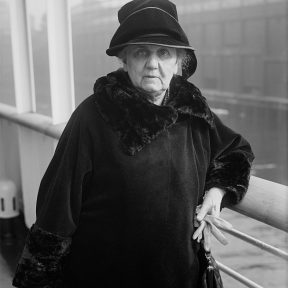
Jane Addams
Overview
* First President of the Women’s International League for Peace and Freedom
* Was designated as a traitor by the Senate Judiciary Committee
* Early advocate of the welfare state
Born to a prominent Quaker family in Cedarville, Illinois in 1860, Jane Addams attended Rockford Seminary for Women and graduated as valedictorian in 1881. That same year, she was devastated when her father died suddenly from a ruptured appendix.
The father’s estate left Jane Addams sufficient funds to live at leisure. After a period of hospitalization for a congenital spinal defect, she enrolled at the Women’s Medical College in Philadelphia but withdrew after one semester. Struggling with depression and physical pain, she spent time in the Mitchell Hospital of Orthopedic and Nervous Diseases, where her condition actually declined. But in 1882 Addams’s brother-in-law, who was a medical doctor, operated successfully on her back and corrected the spinal curvature.
After recovering from her physical ailments, Addams made two trips to Europe. On a visit to London in 1887, she was horrified by the poverty in the city’s East End. On a subsequent visit, Addams visited Toynbee Hall, a settlement house designed to serve the urban poor in London, and she resolved to create a similar institution in the United States.
When Addams returned to Chicago, she and her friend Ellen Gates Starr co-founded Hull House — which would eventually become the best-known settlement house in America — in a somewhat dilapidated mansion on Halstead Street. (The mansion had been built by the real-estate developer Charles J. Hull in 1856.) Hull House opened its doors to the public in 1889 and gradually broadened the range of services which it offered, including courses in English, German, French, art history, cooking, drawing, singing, piano, athletics, chemistry, and math. It also formed reading groups, youth clubs, and such entities as a Debating Club, a Pansy Club for girls, a Youth Citizens’ Club for boys, a Boys’ Club Brass Band, an Art Studio, a Library, a Music School, and a Labor Museum. By the early 1900s, Hull House consisted of 13 buildings and 40 staff members.
In addition to its benign and charitable tasks of creating cultural and educational opportunities for working-class immigrants and the working poor, Hull House quickly became engaged with the socialist movement. A watershed moment in this regard was when Addams and Starr were joined by the Marxist social worker Florence Kelly, whose translation of Friedrich Engels’ Conditions of the Working Class in England had been published in the United States in 1887. Kelly’s arrival signaled a radicalization in Hull House’s agenda.
Troubled by “overaccumulation at one end of society and destitution at the other,” Addams herself grew ever-more fond of socialism and became increasingly vocal in her demand that the government supply welfare services to the poor. She developed into one of the earliest and most determined advocates of the welfare state.
Hull House staffers immersed themselves in the Chicago and Illinois politics of the day. Addams, for instance, became the garbage commissioner of the city’s 19th ward; others were appointed to different state and local commissions. Addams also became embroiled in one of the great labor disputes of her time, the Pullman Strike of 1894. In writing of the strike, Addams made clear Hull House’s unequivocal support of trade unionism. She further insisted that capitalism conflicted with her group’s “ethical demands” not only for “social righteousness but for social order.”
As time passed, Addams became ever-more involved with pacifist causes as well as social and feminist issues. In 1909 she became a charter member of the NAACP, and two years later she was named the first vice president of the National American Women’s Suffrage Association.
By 1910, Addams had become the leader of a national movement that included the establishment of more than 400 settlement houses across the United States. Other women gradually took over the task of running Hull House on a day-to-day basis, thereby freeing Addams to spend more time traveling, speaking, and writing about social reforms such as child labor legislation, housing and sanitation reform, immigrant welfare, temperance, women’s suffrage, and labor mediation.
Addams became friends with Theodore Roosevelt and supported his 1912 nomination for the presidency, though she later earned Roosevelt’s scorn for her pacifist views.
During the early phases of World War I, Addams allowed Hull House to be used as a “conscription center” for the American Union Against Militarism (AUAM), which aimed to keep the U.S. out of the conflict in Europe. In 1915 Addams became chairman of the Women’s Peace Party, and in April of that year she presided over the first International Congress of Women at The Hague. From that Congress, the International Committee of Women for Permanent Peace (ICWPP) was born. In 1916, Addams testified in support of disarmament before the Military Affairs Committee of the U.S. House of Representatives.
When the AUAM in 1917 split into two factions — a moderate faction which retained the AUAM name, and an aggressively anti-conscription faction named the National Civil Liberties Union (NCLU) — Addams sided with the latter. After the NCLU emerged as the American Civil Liberties Union (ACLU) headed by Roger Baldwin, Addams served on its national committee.
In 1919 the ICWPP changed its name to the Women’s International League for Peace and Freedom (WILPF), and Addams became its first president — a post she would hold for ten years. In 1919 as well, Addams’s name was placed on attorney Archibald Stevenson’s “traitor list,” which was shown to the Overman Subcommittee of the Senate Judiciary Committee.
Addams had a heart attack in 1926 and never fully regained her health thereafter — suffering several more heart attacks after 1931. She was awarded the Nobel Peace Prize in 1931, and she died on May 21, 1935.
Further Reading: “Jane Addams” (NPS.gov, International Encyclopedia of the First World War, WomensHistory.org).